It's Time for White Parents of White Kids to Bring the Resistance Home
By Gayle Kirshenbaum
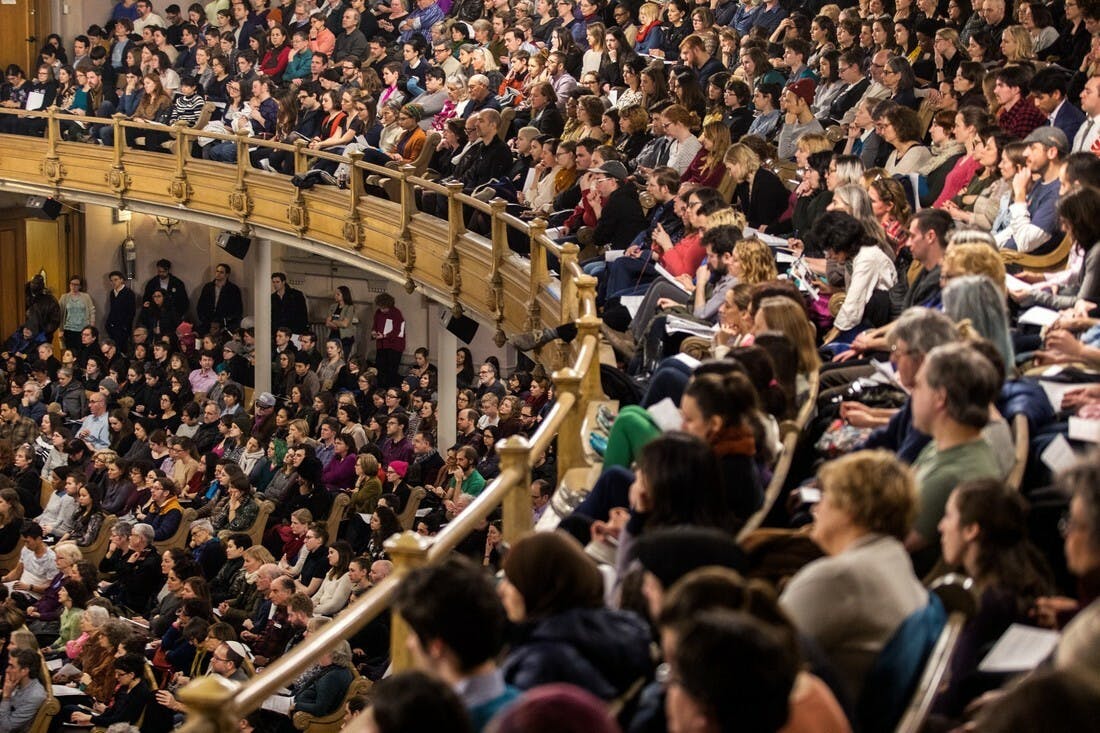
“Get Organized Brooklyn” community meeting (Photo Credit: Demetrius Freeman, The New York Times)
Recently, I joined more than 1,000 people in Park Slope, Brooklyn at a community meeting convened to resist Trump’s agenda. One of the speakers was Hebh Jamal, a 17-year-old Muslim student who led a citywide student walkout to protest the travel ban and Trump’s anti-immigrant policies.
She’s also a leader in the movement to desegregate New York City schools, among the most segregated in the country.
She looked out at the nearly all-white, upper-income crowd — which included many parents — and asked us to recognize ourselves and our children as beneficiaries of a rigged educational system. While this is a known and somewhat lamented fact in our liberal community, the silent room got a little more silent as we contemplated ourselves as both new resisters and longtime collaborators.
We’re now past the 100-day mark of an administration infused with the spirit of white nationalism. I feel myself to be living a split-level life: upstairs, in the public realm, I continue to call my representatives and go with my family to protests; downstairs, on the subterranean level, I’m wading through the muck of my own whiteness.
This is not a place I want to be.
What do you like about being white?
This was the question posed to me and other participants of a workshop I attended a month after the election, which was called Undoing Racism. Although I’ve been engaged in social justice work my entire adult life, it wasn’t until the Black Lives Matter movement that I started to fully reckon with myself as a white parent of a white child. In our household, I’ve spoken with a whole lot of concern about racism — but not with much urgency.
And during my nearly 16 years of parenthood, I’ve rarely spoken with other white parents about what it means to be raising the next generation of white people.

Post-election protest (photo credit: latimes.com)
In the workshop, we sat in a tight circle for two days. The trainers were as diverse as the room, some of them middle-aged or older. Trump, to my surprise, didn’t command their attention. They talked about race in this country with a fierce kind of equanimity, a degree of remove from the present moment.
As people began to describe what it’s like to move through their lives as black, Latina, Chinese-American, or white, I also felt myself detach from the headlines and begin to quiet down. I understood why the emotional temperature of the room was so carefully, expertly regulated. Silence was respected and humor welcomed, though this was not group therapy. It was a process of collective witnessing, of watching each other begin to tell the truth.
What do you like about being white?
I was expecting, at this training, to wholeheartedly acknowledge my white privilege. I’ve been very good at this for years.
But I wasn’t expecting to hear myself say, "I like that I can use the bathroom wherever I am. I like that I can walk into any building I want to. I like that as a white woman I’m never perceived as a threat and that I’ve been smiled at my whole life."
This, I’ve come to know, is most usefully experienced not as a confession of sin, but as an acknowledgment of fact. I’ve been learning to depersonalize my racism in order to take responsibility for it. To locate it in the institutions that have shaped me. To understand white superiority as an inherited condition, a mindset not of my choosing but that I have been socialized to carry and to transmit. It feels less a source of personal shame, than a thing that I can hear and see and smell. I think of my whiteness as a still active construction site, which was set up the day I was born.
As it was for my child.
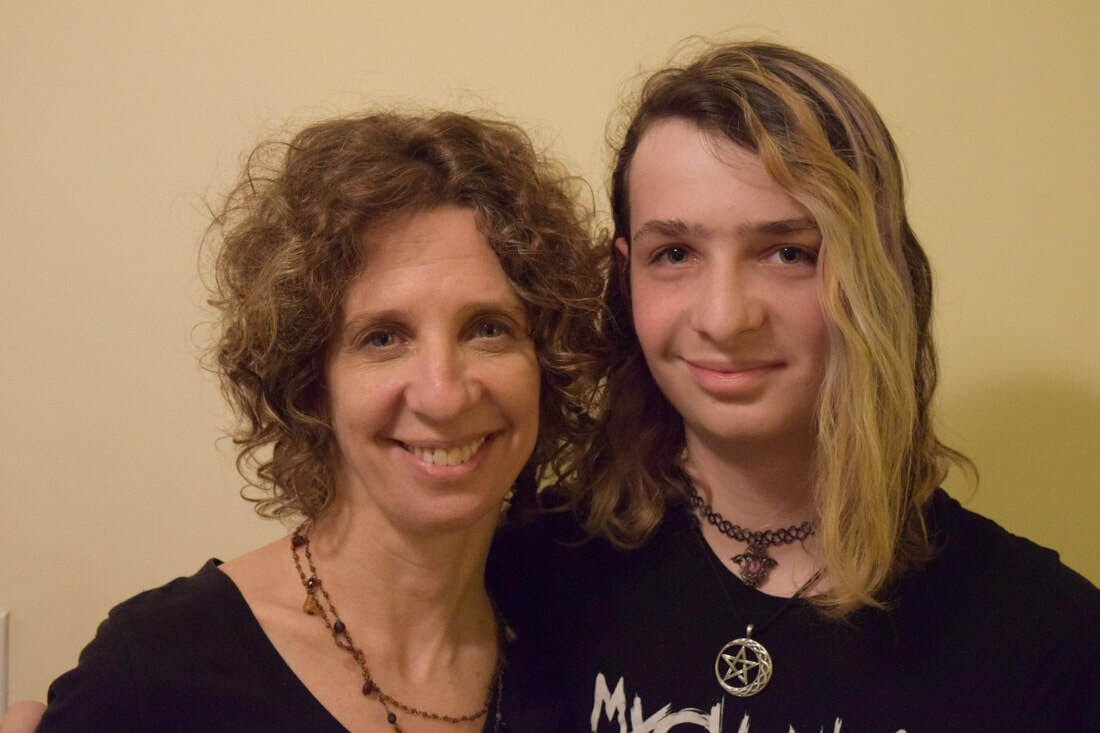
Gayle and her child, Aaron
Playgrounds.
Just before the election, a friend of mine who is raising an African American boy told me of her overwhelming pain when watching him attempt to play in a Minneapolis playground and be shunned by the white children whom he’d approached. This was not the first time she’d seen her child, the only child of color in a play group, excluded in this way — an exclusion that was not noticed or challenged by the attendant white parents.
“My son already doesn’t like his skin color. He’s five.”
We’d never talked about this.
My friend is a white woman married to an African American woman and they have had many discussions about race with their child.
When she told me about her son’s experience on the playground, I wanted to imagine that I would have been the “good” white parent, the one who recognized what was happening and stepped up in some way. But I very much doubt it. I would likely have told myself I wasn’t seeing what I was seeing so that I wouldn’t have to figure out what to do about it.
When my child was five, we weren’t yet discussing race head on. My husband wanted to start the conversation, but I wanted to do more research. I wasn’t sure what the right time was. I wanted to do it the right way. Looking back, though, I see as much complacency as anxiety. I never did the research I planned to do. As part of a family embedded in a progressive community, I gave myself a pass. I seemed to believe that the necessary conversations about race and racism would be transmitted to my kid by osmosis.
Another friend, a parent and teacher who is African American, wondered if my anecdote about this five-year-old boy’s experience on the playground would be truly understood by white readers of this essay. Would they feel its full impact? For her, this story immediately brought to mind the story of six-year-old Martin Luther King, Jr., whose white friends were one day told by their mother that they could no longer play with him.
She noted that 82 years later, “what is at stake for us in a Trump America, is what has been at stake for us always.”
While I’ve wanted to believe that we’ve traveled a great distance from that overtly racist white mother of the 1930s, it’s now clearer to me than ever that that distance can only be measured by the actual experiences of children on today’s playgrounds — not by a playground’s “diversity” and not by our intentions as white parents.
Conversations about race have to start much earlier than most white people think they do — and we have to keep the conversations going.
We have to identify all the ways that the benefit of the doubt accrues to white teens as they walk down the street, play around, act out — or walk into school.
Benefit of the doubt
When my white 15-year-old brought a knife into school to cut apples to demonstrate a Jewish holiday ritual, the knife was confiscated by security guards, but they were waved into class. (My child identifies as non-binary and uses the pronoun, “they.” It’s important to note that the security guards perceived my child to be male — and as a perceived white male, less of a threat than a black male.)
Absence of benefit of the doubt
When a student of color walked into the same building with a pin holding his broken eyeglasses together, the guards took his glasses and confiscated the pin. When the student tried to retrieve his glasses, he was forced to the ground and handcuffed.

We have to have conversations about race in the moment, when our kids come home from school or parties or the mall, when they’re taking off their coats, when we don’t think we have the right words, when they don’t want to talk to us about anything, but when real life is happening.
I’ve talked with my kid about the fact that it was my idea to send the knife to school — and that I strongly doubt that a mother of a child of color would ever pack a knife in her child’s backpack.
And I continue to think about all of the ways that I will never worry, the way that parents of children of color worry, about the infinite number of ways the world might threaten their children’s sense of self-worth, aspirations, and physical safety.
I try to imagine what I can’t: the goodbyes at the door, the trips on the bus, the subway, the highway. Visits to toy stores and grocery stores, meetings with teachers and principals. The encounters with neighbors, librarians, nurses and doctors. The messages from textbooks, the media, Hollywood, the publishing industry. The scrutiny by taxi drivers, judges and juries, prospective employers and landlords. The self-scrutiny that can lead to suicide. The stops by police officers patrolling on foot or in cars, in cities and suburbs.
The weapons drawn.
On April 29, a white police officer in a Dallas suburb fired his AR-15 rifle into a car with five black teenagers. They had just left a party. An unarmed 15-year-old, Jordan Edwards, was fatally shot in the head.
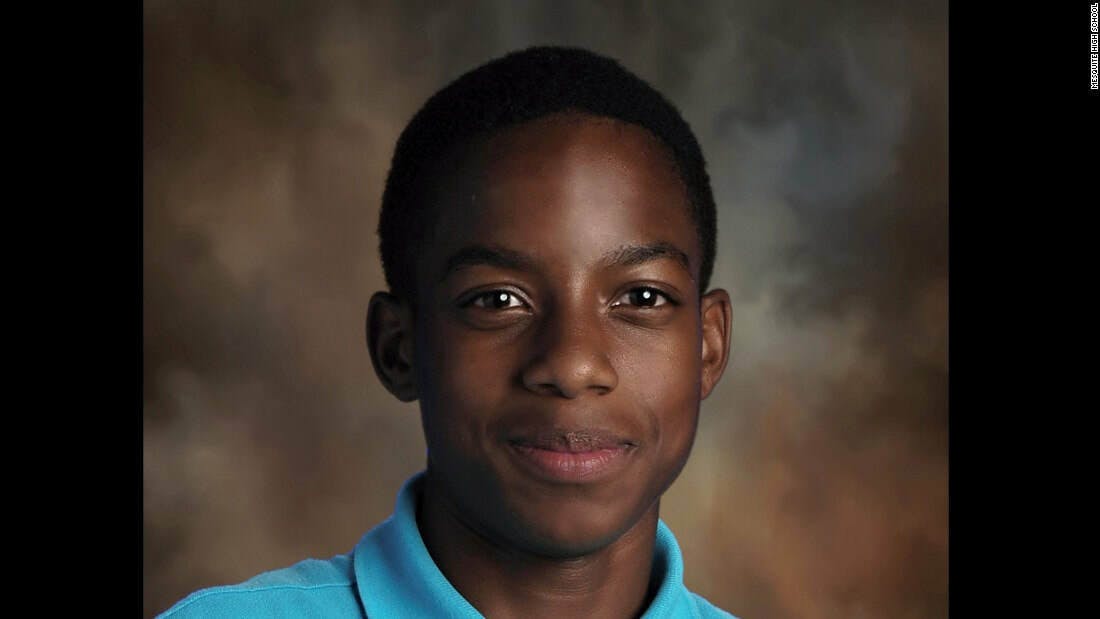
Jordan Edwards in a recent Mesquite High School yearbook photo
The ADL reports that white supremacists have dramatically scaled up college recruiting efforts in more than 33 states, resulting, since January, in a surge of racist, anti-Muslim, and anti-Semitic propaganda. As a Jew, I feel newfound anxiety. As a Jew who is also white, I feel the imperative to join with other parents to help our children see the daily privilege of their whiteness; see the illusion of superiority it conveys; understand how their racism is being constructed; and take action to combat the system that took the life of Jordan Edwards.
“White parents of white kids need to start talking to each other,” said my friend, the mother of the five-year-old boy. “And it’ll all be imperfect, really hard and messy.”
Living rooms. I’ve found it exhausting to perform my parenting for other parents. I’ve spent years pretending not to be confused or hypocritical or complicit in perpetuating in my family or the world the many things I decry: materialism, competitiveness, narcissism, racism. But I’ve also been lucky enough to learn what can happen when the opposite is true — when I can stop pretending for a few hours at a time.
When my child was three months old, we hired a part-time nanny, a woman who was born in Jamaica and is the mother of three boys. She had been a childcare provider for a decade before she worked for us. I had no idea how to hire someone to care for my child. And I was deeply uncomfortable with how it all “looked,” but I squirmed silently. Many white families in my neighborhood hire nannies who are immigrant women of color. It’s a community norm to hire a nanny and a community norm never to talk about race.
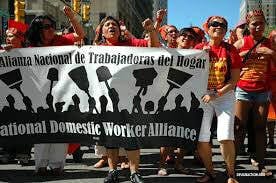
Members of the National Domestic Workers Alliance (Designaction.org)
Our childcare provider came into our home with much good will, patience, and experience — but I felt nervous and confused about how to be an employer. So did other parents in my community, and we finally got together in someone’s living room to talk about it.It was a relief — and a profound challenge — to tease apart all of the threads of race, class, gender, and immigration status that run through the domestic workplace.
Ultimately, those living room meetings got real — we talked about our ambivalence about leaving our kids, our inherited attitudes about “the help” and “women’s work” — and we got somewhere. We partnered with domestic worker activists and, after a lot of fits and starts, helped found a national organization — Hand in Hand — to support domestic employers like us, people who wanted to be fair employers but had no idea what that looked like.
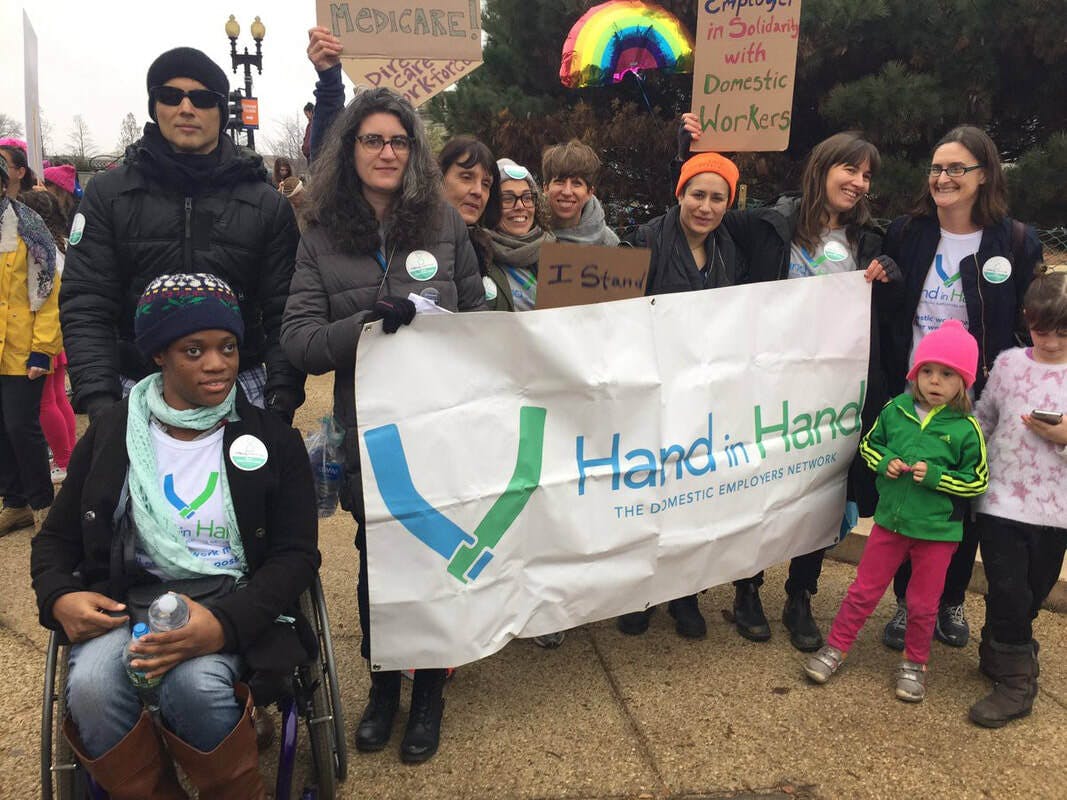
Hand in Hand members at the Women’s March on Washington, January 2017
I’m now a true believer in the living-room-approach to starting conversations that feel overwhelming and exposing.
We have to clean our bathrooms, set out some food, and invite over our white friends to keep writing letters to Congress and also to talk — with as little judgment and as much honesty as possible — about our relationship to race as we grew up; about how our families talked about race; about how we are or aren’t talking about race and our racism with our partners and kids; about school segregation and the resources that are reserved for our white children; about what is or isn’t happening in our homes, schools, and communities to help our kids understand and fight racism and do better than we are.
If we get better at doing this, we might get better at talking to our white relatives and neighbors who voted for Trump. Although we won’t know where the conversations will end, we might know where to begin.
What to do:
Keep showing up in the streets and at town halls to denounce the intensifying racism, xenophobia, Islamophobia, and anti-Semitism in this country.
Recognize that these things are both important and relatively easy to do.
Understand that as white people, we’ve been incentivized to do nothing difficult — nothing that would disrupt a society that has been structured to ensure that our children’s whiteness is determinative of a lifetime of opportunity and safety. For me, confronting this fact is where ease evaporates. Which is why we need to confront it together.
How do we do that?
Find out who’s leading work on racial justice and educational equity in your community. Listen and learn how you can best support these efforts. Join Showing Up for Racial Justice, a national group that organizes white people for racial justice and has a network for families. Invite people over for an interactive webinar facilitated by Raising Race Conscious Children and join the conversation at Embrace Race. Sign up for an Undoing Racism workshop. If you’re an employer of an immigrant domestic worker— a childcare provider, housecleaner, or home attendant — who is being targeted by this administration, join Hand in Hand’s Sanctuary Homes campaign. If you’re a teacher, visit Teaching Tolerance. Support Dignity in Schools to fight the school-to-prison pipeline.
Imagine if the hundreds of thousands of parents who mobilized around the country to fight high-stakes testing now start mobilizing as anti-racist parents. Anti-racist parenting can be — must be — community parenting. Imagine if white people believed that this fight was not “for” people of color, but for every one of us. If we could finally see how racism has damaged our own minds and hearts and is damaging our children.
That would put both love and justice at the center of the fight.
That’s how we play the long game against Donald Trump.
Addendum
As this piece has circulated in the last few weeks, I’ve been thinking about what I’ve learned, what I’ve missed, and what work I’ll need to keep doing to be an effective anti-racist parent and activist. I’ve been reflecting on the fact that the comments shared by white readers have been almost uniformly positive and that some readers of color have had critical responses and posed these questions:
1) Why did I tie the article to Trump? Will I and other white parents retreat from the fight against racism under a different administration?
2) Why didn’t I more fully address white parents’ responsibility to fight white supremacy (or “white pseudo-supremacy,” as one reader wrote)?
3) Why didn’t I include black- and brown-led organizations in my resource list?
I appreciate that EmbraceRace invited me to write this addendum as a way of furthering the discussion — and I appreciate the readers who have taken time to engage the piece thus far.
Here are my current thoughts in response to the questions:
1) I tied this piece to Trump because I wanted to highlight both the overt white nationalism of this administration and the fact that Trump is bringing many more liberal white people into activism — people who must recognize the need to commit to long-term anti-racist/anti-white supremacy organizing and parenting. This is what I felt to be the point of the piece: that new “resisters” who are white must understand that this work transcends this moment and Trump. That this is the work of a lifetime — ours and our children’s.
I’d hoped that my piece made this clear, but I see now that I could have been much more direct. I might also have asked:
What does it mean that so many white people are experiencing the reward of seeing ourselves — and being seen — as pro-immigrant, anti-racist, anti-Trump warriors?
What will happen when this reward is gone?
What will I — what will we — be doing to fight racism and white supremacy when Trump is out of office — or when we get used to him?
2) The concept of white supremacy should be much better explicated for white parents than it was in this piece, which I conceived of as only the beginning of a discussion about anti-racist parenting. But I know that I can and must get better at addressing my internalized white superiority as part of discussions of racism of any length and in any context. We have to recognize and then combat the ways we carry our sense of white superiority with us wherever we go, no matter our politics. No matter our engagement in anti-racist organizing.
In “Deep Denial: The Persistence of White Supremacy in United States History and Life,”
David Billings writes: "Why are the feelings and attitudes of white superiority not examined in clinical settings? Why are they not part of our professional training? Surely the impact of Internalized Racial Superiority is something that should be studied in school, not just as prejudice or discriminatory behavior, but as a psychological condition, perhaps even a disorder, among white people.”
3) Apart from directing people to find out about who’s leading racial justice and educational equity work in their communities, I was reluctant to direct white people to specific black- and brown-led community organizing groups without first being part of a process with other white people to learn how to be accountable participants in racial justice work. So I headed the list with SURJ. I included Raising Race Conscious Children as an especially practical resource to support parents of white kids who want concrete advice and training.
Also, to clarify for people unfamiliar with some of the organizations I listed:
- EmbraceRace is led by people of color.
- Dignity in Schools describes itself as a coalition consisting of “multiple stakeholder groups — youth, parents, educators, and advocates — and we strive to be led by people most affected by school pushout and zero-tolerance discipline.”
- Undoing Racism/The People’s Institute for Survival and Beyond describes itself as a “national and international collective of anti-racist, multicultural community organizers and educators.”
- Hand in Hand works in partnership with the National Domestic Workers Alliance, which represents domestic worker affiliate organizations around the country and prioritizes the leadership of women of color.
I welcome additional resources as well as thoughts about how we create our resource lists in what hopefully will be an ever-expanding anti-racism and anti-white supremacy parenting movement.
Gayle Kirshenbaum



